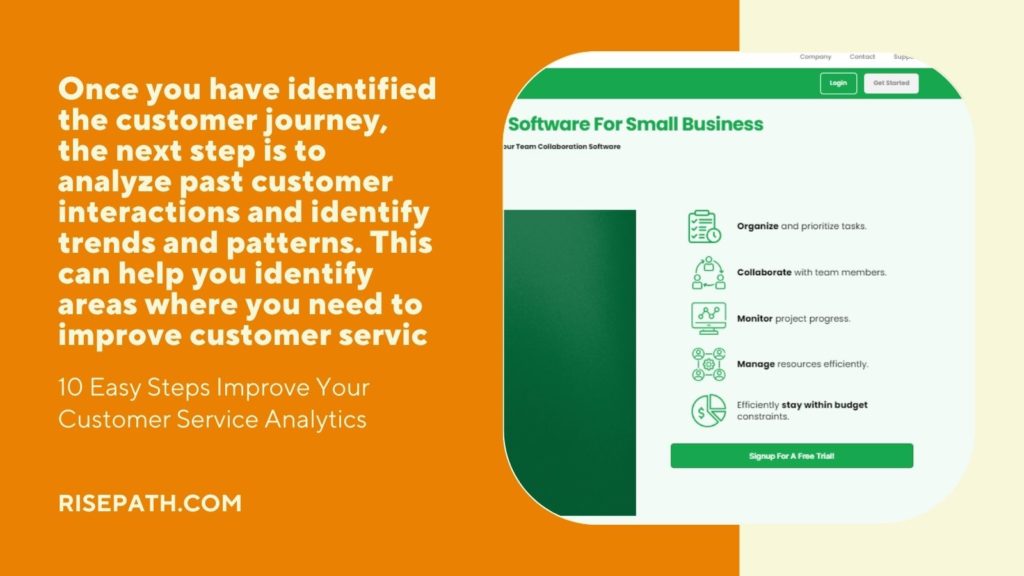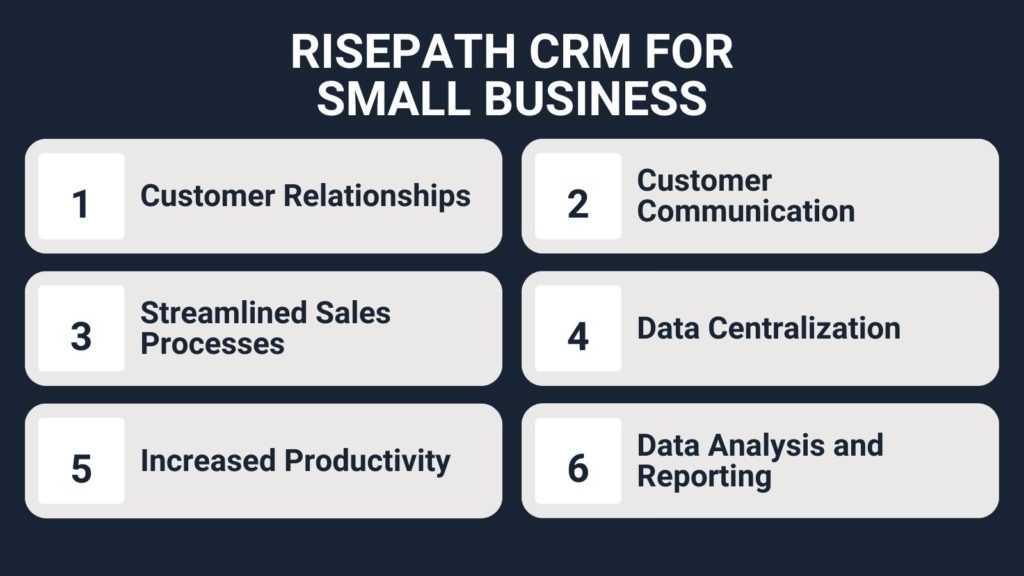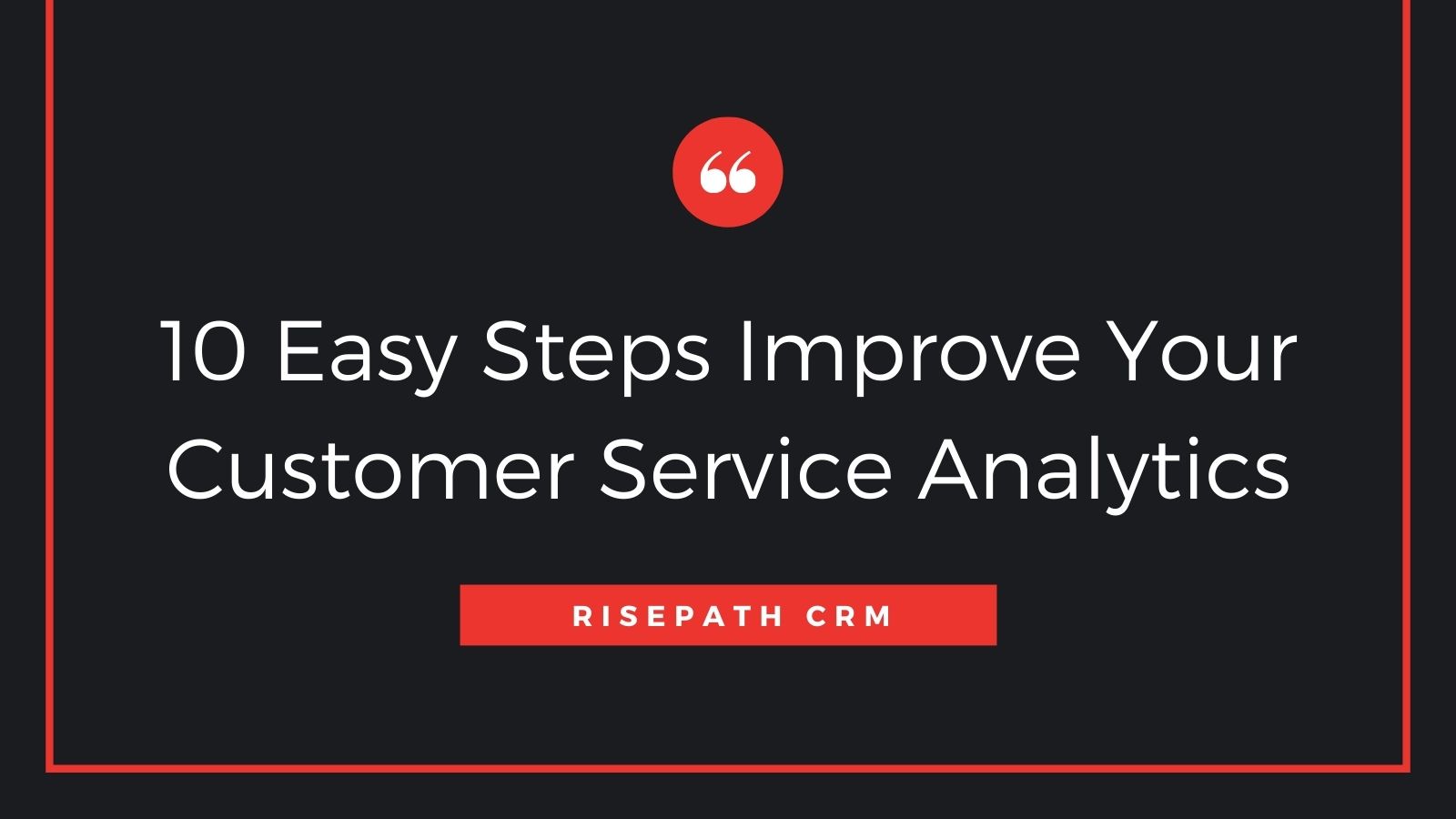Advanced customer experience analytics enables you to gain useful insights into consumer behaviour while also assisting you in identifying customer needs and mapping customer expectations.
Customers want your firm to provide them with a tailored experience. When they don’t get it, though, around 71% of customers are likely to be dissatisfied with your company. Customer Service Analytics enables you to please your customers, resulting in increased loyalty and sales.
Welcome to the digital age, where customer service isn’t just about solving issues, but about harnessing the power of data to transform each interaction into a meaningful relationship. In our increasingly competitive business landscape, understanding and enhancing your customer service analytics is pivotal to staying ahead of the curve. But with mountains of data at your fingertips, where do you start? Fear not, because in our latest blog post, we’re breaking down ‘How to Improve Your Customer Service Analytics in 10 Easy Steps’.
Whether you’re a small business owner or a customer service manager at a large corporation, these straightforward strategies will help sharpen your analytical skills, optimize your customer service performance and ultimately, win over the hearts of your consumer base. Ready to gain actionable insights and elevate your customer service game? Let’s dive in!
10 Steps for Improving the Customer Experience
Improving your customer service analytics is key to providing the best customer experience. By understanding and analyzing customer service data, you can better understand customer needs and optimize customer service processes. Here are 10 easy steps to improving your customer service analytics:
Step 1: Know your customers well
Good customer service analytics are essential for successful businesses. By understanding your customers’ needs and preferences, and tracking their satisfaction, you can make sure that your services are meeting customer expectations. Here are 10 easy steps to improve your customer service analytics:
1. Understand who your customers are and what their needs are. Researching your target market can help you better understand their needs and preferences. By learning about your customers, you can ensure that your services are tailored to meet their needs.
Also Read: How Workforce Analysis Can Transform Your Small Business
2. Gather feedback from customers to gain insights into their experiences. Ask your customers for their opinions on your services and products. This will give you a better idea of how customers are responding to your services and products.
3. Analyze customer data to identify patterns and trends. By studying customer data, you can uncover trends in customer behavior and preferences. Use this data to inform decisions about how to improve your products and services.

4. Use customer surveys to ask questions about customer preferences. Surveys are a great way to collect feedback from customers about their experiences with your services. Ask questions about customer satisfaction levels, preferences for different products and services, and any areas of improvement.
5. Improving customer service analytics begins with a deep understanding of your customers and how they interact with your business. Monitoring customer interactions is a key element in gaining this understanding. This can involve a variety of strategies and tools designed to capture and analyze data from every touchpoint a customer has with your service, from initial contact to post-sale support.
Here are some specific ways to monitor and understand customer interactions for better customer service analytics:
a) Implement Tracking Tools: Utilize analytics tools such as Google Analytics, heatmaps, or customer relationship management (CRM) software to track how customers use your website or interact with your online services. Analyzing traffic patterns, behavior flows, and conversion funnels can provide insights into which services are most engaging and where customers may be experiencing issues.
b) Conduct Surveys and Collect Feedback: Solicit feedback using surveys, feedback forms, or live chat sessions to understand customers’ thoughts and feelings regarding your services. This direct communication can highlight areas for improvement and pinpoint what customers value most.
Also Read: Creating a Engaged Remote Team Building
c) Analyze Support Tickets: Review the issues reported in support tickets to identify common problems or areas where customers are frequently confused or dissatisfied. This data can reveal trends and facilitate targeted improvements.
d) Social Media Listening: Monitor social media for mentions of your business. Customers often use platforms like Twitter or Facebook to express their opinions or seek assistance. Social listening tools can aggregate this data and provide actionable insights.
e) Record Customer Service Calls: If your service includes phone support, consider recording calls (with customer consent) and using speech analytics to identify common questions or concerns. Audio analysis can reveal keywords and sentiment that can be helpful in refining your customer service approach.
f) User Testing and Customer Interviews: Conduct user testing sessions and one-on-one interviews to directly witness how customers are using your services. Observing their behavior and gathering qualitative data can provide nuanced context to complement your quantitative analytics.
Also Read: Why workflow management tools are still relevent in 2023
g) Use Net Promoter Score (NPS): Measure customer loyalty and satisfaction by using NPS. This metric can help you gauge the overall sentiment towards your service and identify promoters and detractors.
h) Customer Journey Mapping: Create maps that visualize the customer’s journey from the initial awareness stage through to post-purchase. This can help contextualize the data and reveal friction points along the path.
By monitoring these interactions and capturing data, you can gain a well-rounded picture of your customers’ experiences. By understanding how customers engage with your services, you can identify areas where your customer service is thriving and where there is room for improvement. This step is crucial in optimizing your services and ensuring that customer interactions are as positive and productive as possible.
With the insights gained from this analysis, you can customize your communication, personalize service, and ultimately boost customer satisfaction and retention, which can have a measurable impact on your business’s success.
Step 2: Map the entire customer journey
Improving customer service analytics has become one of the top priorities for many businesses. Knowing how to effectively measure customer satisfaction and interaction is essential for providing great customer service. Fortunately, there are several steps you can take to improve your customer service analytics in 10 easy steps.
The first step is to identify key customer touch points and map out your customer journey. Understanding the customer journey can help you better understand how customers interact with your business and what kind of experience they have. This mapping process will also help you pinpoint areas where you can improve customer service.
Also Read: CRM vs CMS what to choose for your small business
Once you have identified the customer journey, the next step is to analyze past customer interactions and identify trends and patterns. This can help you identify areas where you need to improve customer service. It is also important to document customer feedback and use it to improve your customer service. Utilizing analytics tools to measure customer service performance can help you track customer satisfaction and make sure it is meeting your goals.
Creating a customer service scorecard to measure customer satisfaction is another great way to improve customer service analytics. This scorecard should include metrics such as response time, customer satisfaction, and customer retention. Setting customer service goals and tracking progress can also help you improve customer service analytics.
Mapping the customer journey
Mapping the customer journey is a critical step in understanding and enhancing your service analytics. It’s not just about pinpointing where your customers interact with your brand, but also understanding their feelings, motivations, and pain points at each stage.
1. Identify All Customer Touchpoints: Begin by identifying every point at which the customer interacts with your business, both online and offline. This includes social media, your website, customer service calls, emails, chats, purchase and checkout processes, product delivery, and even post-sale services.
2. Gather Data Across all Channels: Next, ensure you’re collecting data from each of these touchpoints. In the context of SEO and digital presence, this might involve tracking metrics such as page views, time on site, bounce rates, conversion rates, etc.

3. Analyze Customer Feedback and Complaints: This is where customer feedback and complaints become invaluable. They provide a direct line to your customer’s experiences and sentiments. Whether it’s through survey responses, comment sections on your web pages, or direct customer service interactions, this feedback can reveal gaps and inefficiencies in the customer journey that might not be evident from quantitative data alone.
Qualitative Analysis: Dive deep into the comments and reviews. Look for recurring themes or specific instances where customers express dissatisfaction. By employing tools such as sentiment analysis, you can systematically evaluate the emotions behind customer interactions. –
Root Cause Analysis: Use complaints to understand the underlying issues. For example, if you notice repeated complaints about late deliveries, it might be an issue with your logistics partner or your internal dispatch system.
4. Integrate Feedback into Analytics: Integrate the findings from this qualitative analysis into your broader customer service analytics. This might involve tagging customer feedback to specific stages of the customer journey or even certain SEO-related issues, such as problematic content on your site or technical SEO issues that make certain pages hard to find or use.
5.Close the Loop: After mapping the customer journey and identifying issues through feedback, it’s crucial to “close the loop.” This means taking actionable steps to address the problems discovered. For instance:
If customers are struggling to find information on your website, it might be time to improve your site’s content hierarchy and on-page SEO.
Also Read: The Power of AI-Generated Content in Digital Marketing
If customers report poor customer service experiences, consider training your staff more effectively or employing more intelligent CRM systems.
6. Iterate and Improve: Customer service analytics is not a one-time task but an ongoing process. As you make improvements based on customer feedback, continue to map and analyze the customer journey, ensuring each iteration is better than the last. Monitoring SEO metrics along the way will help ensure that your digital touchpoints remain optimized and effective.
Step 3: Be receptive to feedback
Improving your customer service analytics can be a challenging task, but it doesn’t have to be. By following these 10 easy steps, you can ensure that you are always taking customer feedback into account and making the necessary changes to your customer service processes.
First and foremost, be open to feedback from customers regarding their experiences with your customer service. Gather customer feedback from multiple sources, such as surveys, customer service calls, and online reviews. Use this feedback to identify areas for improvement and areas where customer service is excelling. Use this analysis to inform changes to your customer service processes and create a plan to address customer feedback.
Once the plan is in place, actively monitor customer feedback to track the success of changes made to your customer service analytics. Make customer feedback a priority and strive to consistently improve your customer service analytics. Ensure customer feedback is always taken into account when making decisions about customer service processes. Respond to customer feedback in a timely manner and address any issues in a professional manner.
Finally, create a feedback loop to ensure customer feedback is always taken into account and used to improve customer service analytics. This will help ensure that your customer service analytics remain up to date and effective in helping to provide customers with the best possible experience. By following these 10 easy steps, you can ensure
Step 4: Create a customer-centric corporate culture
Improving customer service analytics can be a daunting task, but it doesn’t have to be. By taking the right steps, any organization can increase their customer service performance and insights. Here are 10 easy steps to help you improve your customer service analytics:
1. Instill a customer-centric corporate culture that puts the customer first in all decisions and objectives. This means that from the top down, everyone in the organization should have a customer-first mentality.
2. Establish an attitude of customer service excellence throughout the organization. This should include setting expectations for customer service performance, providing feedback on customer service, and rewarding staff for providing superior customer service.
3. Encourage open dialogue between customers and employees to foster a better understanding of customer needs. This dialogue should include feedback from customers about their experience with your service, as well as suggestions on how to improve.
4. Provide training and development to staff on customer service best practices. This could include courses on customer service skills, customer service trends, and customer service technologies.
5. Reward and recognize employees for providing exceptional customer service. This could be in the form of bonuses, promotions, or other incentives for providing excellent customer service.
Step 6: Overdeliver on customer service options
Providing excellent customer service is essential to running a successful business. But how can you make sure your customer service is up to par? With customer service analytics, you can identify areas for improvement and make changes accordingly. Here are 10 easy steps to improve your customer service analytics.
First, offer customers multiple ways to contact you, including phone, email, chat, and social media. This will ensure customers can always reach you when they need help. Additionally, monitor customer feedback in real time and respond quickly to any complaints or concerns. This will show customers you care about their feedback and are actively working to improve their experience.
Second, utilize customer feedback surveys to collect valuable data about customer satisfaction. This will give you an accurate picture of how your customers feel about your product or service. Additionally, keep customer service channels open 24/7 in order to provide timely support and assistance. This will show customers you are reliable and available when they need help.
Third, make the customer service experience as easy and seamless as possible. Streamline your customer service processes by creating helpful FAQs and incorporating automated customer service solutions.
Step 7: Empower customers with self-service choices
If you want to improve your customer service analytics, you have come to the right place. In this article, we will provide you with 10 easy steps to do just that.
The first step is to establish a self-service portal or website for customers to access information about your products and services. This will allow customers to find the answers to their questions quickly and easily, without having to wait for a customer service representative to respond. Additionally, you can offer online customer service chatbots to answer customer inquiries quickly and effectively. This will reduce wait times and improve customer satisfaction.
The second step is to provide an online knowledge base for customers to search for answers to their questions. This will enable customers to get the information they need without having to contact customer service. Additionally, you can use social media platforms to answer customer queries in a timely manner. This will improve customer service response times and increase customer loyalty.
The third step is to utilize automation to create personalized customer service experiences. Automation can help you create customized customer service experiences that will make customers feel valued and appreciated.
Additionally, make it easy for customers to reset their passwords or access other account information. This will ensure that customers can access their accounts quickly and easily.
Step 8: Reward loyalty and retention
Improving customer service analytics can be a daunting task, but it doesn’t have to be. With a few simple steps, any business can start to improve customer service analytics in no time. Here are 10 easy ways to do it:
1. Offer incentives to customers who remain loyal and become repeat customers. Customers who purchase multiple products or services in a short period of time should be rewarded with discounts and other incentives.
2. Encourage customers to refer family and friends and offer incentives for doing so. Offer discounts, bonuses, or other rewards to customers who refer others to your business.
3. Develop customer loyalty programs that offer rewards for continued patronage. This is a great way to reward customers who keep coming back to your business.
4. Send personalized emails to loyal customers to thank them for their business and remind them of the benefits of staying with your company. This helps customers feel valued and appreciated.
5. Track customer retention rates to measure the effectiveness of any loyalty and retention tactics. This will give you an idea of how successful your customer loyalty programs are.
Step 9: Develop adequate training materials
Improving customer service analytics can be a daunting task, but with the right training and support, it can be managed in 10 easy steps. To ensure customer service team members are able to effectively use the customer service analytics system, it is important to spend time creating detailed customer service analytics training materials.
These materials should cover all aspects of the customer service analytics program, from data collection and analysis to customer service metrics and performance management. Additionally, the training materials should be easy to understand and follow, and it is helpful to include visuals and examples to clarify difficult concepts.
Providing ongoing support and guidance is important in order to ensure customer service team members are able to make the most of the customer service analytics system. Online training materials such as webinars, videos, and other interactive tools can be used to keep customer service team members up-to-date on the latest customer service analytics technology.
It is also important to ensure that all customer service team members have access to the training materials and that they are able to review them regularly. By following these simple steps, customer service teams can make the most of their customer service analytics system and improve their customer service performance.
Step 10: Rely on smart data and analytics tools
Good customer service is essential to the success of any business. However, it can be challenging to measure customer service performance and identify areas of improvement without the right analytics. Fortunately, there are a number of steps you can take to improve your customer service analytics in 10 easy steps.
First, utilize data and analytics tools that help to identify customer trends and preferences. This can help you better understand the needs of your customers and tailor your customer service accordingly. Additionally, analyze customer feedback to better understand customer satisfaction and loyalty levels. This will give you insight into how customers feel about your products or services, and how you can improve them.
Next, track customer-facing metrics such as average response time, customer satisfaction scores, and customer complaints. This will provide you with an accurate picture of customer service performance and help you identify areas of improvement.
Also Read: 10 Essential B2B Marketing Strategies to Grow Your Professional Services Firm
Furthermore, use customer analytics to gain a deeper understanding of customer behavior and preferences. This can help you develop targeted strategies that will improve customer service.
You should also develop customer service dashboards that provide visibility into customer service performance. These dashboards should include key performance indicators to measure customer service performance and help you identify areas that need improvement.
Additionally, use natural language processing and machine learning algorithms to analyze customer service conversations.
Innovative ideas to improve customer experience
Improving customer service analytics is essential for businesses of any size. It can help you identify areas of improvement and develop strategies to increase customer satisfaction. Here are 10 easy steps you can take to improve your customer service analytics:
1. Gather customer feedback through surveys and online reviews to assess customer experience. This will give you valuable insights into what customers think of your service and how you can improve.
2. Analyze customer data to identify any weak points in service delivery. This will help you identify any areas you need to focus on to improve customer service.
3. Develop a customer service strategy that focuses on delivering a personalized customer experience. This will help you build customer loyalty and increase customer satisfaction.
4. Make use of customer service analytics tools to track customer service performance. This will allow you to measure customer service performance and identify areas for improvement.
5. Offer training to customer service reps to help them better understand customer needs and expectations. This will help them provide better customer service and build customer loyalty.
6. Develop customer service policies that are designed to increase customer satisfaction. This will help ensure that customer service reps are providing the best possible service.
Enhancing customer experience meaning
Improving customer service analytics is essential for any business that wants to stay competitive in the marketplace. Luckily, it doesn’t have to be a complex process. With the right strategies, you can easily improve your customer service analytics in 10 easy steps.
The first step is to understand your customer needs. Leverage customer feedback to identify what customers need and how they want to receive it. Use data analytics to analyze customer data and identify patterns in customer behavior and preferences. You can also measure customer satisfaction and loyalty with metrics. Utilize customer feedback via surveys, polls, and other methods to understand customer needs and preferences.
The next step is to personalize customer interactions. Use customer data to personalize interactions with customers and provide tailored solutions. Improve customer service processes to ensure efficient and effective service delivery. Increase customer engagement with marketing tactics. Utilize customer service technologies such as chatbots and AI-based systems to enhance customer support. Offer rewards and incentives to customers for loyalty and to encourage repeat business.
By following these 10 easy steps, you can improve your customer service analytics and provide your customers with the best possible service. With the right strategies, you can ensure that your customers are satisfied and that your business is successful.
Conclusion
Equipping customer service agents with the right tools is not just about efficiency, but also about empowerment. By leveraging advanced customer service analytics, agents gain a deeper insight into customer behavior, preferences, and history. This knowledge allows them to tailor their responses and solutions to each customer, enhancing personalization and satisfaction. When agents have access to comprehensive data and analytics, they can make informed decisions, anticipate customer needs, and create a proactive customer service experience that leaves a lasting positive impression.
To integrate this more effectively into your customer service framework, consider utilizing software that collates customer interactions across multiple channels. Ensure that the system includes a user-friendly dashboard that presents key customer insights at a glance. Also, look into incorporating AI-powered tools that can help predict customer inquiries and provide agents with suggestions for solutions, even before the customer has fully explained the issue.
By focusing on these actionable analytics tools, your business can transform its customer service from reactive to proactive, thereby improving customer loyalty and ultimately driving more positive outcomes. This integration represents step six in our strategic plan to enhance your customer service analytics, setting the stage for a robust, data-driven approach to deliver exceptional customer experiences.






Comments are closed, but trackbacks and pingbacks are open.